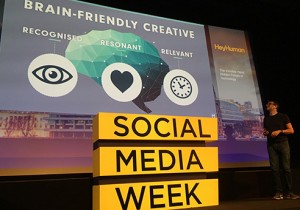PHILIP ELLIS on 15 September, 2016 at 06:09
According to Neil Davidson, Director of HeyHuman, there are more and more “shallow relationships” occurring between consumers and brands. And that makes sense; we’re living in Generation Tinder, after all, our thumbs hovering at all times, ready to swipe to the next distraction.
This is simple neuroscience, says Davidson; “Novel stimulus triggers dopamine.” So if brands and consumers are friends with benefits, is there any way to take that to the next level? In a Social Media Week session entitled ‘Brain-Friendly Social Media,’ HeyHuman served up three neuroscience lessons which can help brands make the most of that casual relationship and ensure that when consumers think of you, they do so fondly.

Recognition
You have to “identify and consciously use brand assets,” says Davidson, but without following the strict rule of the “logo police.” He uses the example of Guinness, which has built a strong brand around the shape of the pint glass, the harp image, and a black and white palette, but deploys these in consistently different ways. Guinness ads have become so iconic that the brand name isn’t even needed.
Resonance
“You have to put the feeling in fleeting,” says HeyHuman’s Aoife McGuinness. This can be achieved by engaging more than one of the five senses at a time. Film has taught us that when sound and visuals are used together, our brain forces us to pay closer attention. Increasingly, touch is found to be effective too; McGuinness expects to see more creators making full use of the vibrate function on smartphones to generate haptic feedback.
Relevance
Once you’ve got that “thumbstop,” how do you keep people interested? “Selective attention is a survival skill; we’re constantly being bombarded,” says McGuinness. “Peripheral attention is important.” Working in synergy with people and platforms can result in social content that offers genuine entertainment, and therefore won’t be tuned out. McGuinness refers to Geico’s pre-roll ad as the gold standard here, which forwent the traditional sales pitch and “began at the end.”
We’re all “digital dopes,” says Davidson. We unlock our smartphones on average 80 times every day, sometimes without any clear purpose. But he thinks that if you can capture someone’s ever-wandering attention, and keep it, then that casual relationship just might turn into something beautiful.